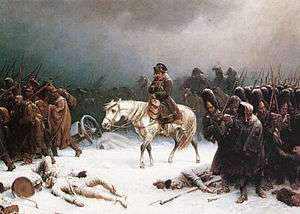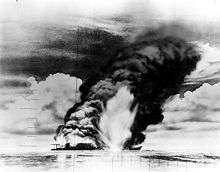Victory disease



Victory disease denotes when in military history, due to complacency or arrogance brought on by a victory or series of victories, an engagement ends disastrously for a commander and his forces.[1]
A commander may disdain the enemy, and believe his own invincibility, leading his troops to disaster. That commander may employ strategies which, if effective in earlier combats or maneuvers, prove catastrophic against a new or smarter enemy; the commander afflicted by "victory disease" may also fail to anticipate a new enemy may use tactics different from those of old enemies. An overconfident commander may disregard military intelligence which would enable the commander to realize that new tactics are needed.
Though "victory disease" does not inevitably foretell defeat, it often precedes it. The term is also applied outside the military world.
Origin
The origin of the term ((戦勝病 senshoubyou) in Japanese[2] is associated with the Japanese advance in the Pacific Theater of World War II, where, after attacking Pearl Harbor in 1941, Japan won a series of nearly uninterrupted victories against the Allies in Southeast Asia and the Pacific.[3][4]
Although the Japanese had planned to establish a perimeter and go on the defensive, victories encouraged them to continue expanding to where it strained logistics and the navy. This culminated in the Battle of Midway in 1942, a catastrophic defeat of the Japanese navy: all four Japanese aircraft carriers involved were sunk, and the hitherto unstoppable Japanese advance was blunted.
History
Pre-modern
- The hubris of Xerxes I led to a catastrophic defeat of the Persian Empire in the Battle of Salamis, which occurred in 480 BC. This was the turning point of the Greco-Persian Wars and the ancient Greeks, who the Persians were opposing, eventually won. The ancient Greek playwright Aeschylus fought in the battle; he wrote the play The Persians in which the Battle of Salamis is a setting.
- In 1415, at the Battle of Agincourt, the English were outnumbered by a factor of four to three, but the disorganization of French knights, as well as superb quality longbows, were the underlying circumstances which led to the English overcoming the odds and annihilating the French.
- The overconfidence and lack of preparation led to the disastrous defeat of the English, led by Edward II at the Battle of Bannockburn to the Scots, led by Robert the Bruce.
- The Spanish naval assault on England in 1588 suffered the defeat of the "unsinkable" Spanish Armada. Similarly, English overconfidence the following year led to the disaster of the English Armada.
19th century
- The calamitous decision by Napoleon to invade Russia in 1812 led to the return of only 10,000 French soldiers when 610,000 had initially been sent out. Napoleon's repeated victories in Central Europe led him to believe that Russia would surrender after a few won battles, and made no plans for a sustained campaign or occupation in Russia.
- The first six weeks of the Franco-Prussian War saw French armies, convinced of their superiority following French victories in the Crimean War and the wars of Italian unification, enter a war with Prussia believing that their weapons and tactics would easily defeat the Prussians. However, the Prussians had better weapons and tactics, and led to catastrophic French defeats at Sedan and Metz.
- United States victories against Mexico and American Indians led Union forces to be overconfident going into the Civil War. Failing to update their tactics to match new technology, such as rifling of firearms and the use of the Minie ball as ammunition, they assumed that superior numbers would give them rapid victories, and ignored plans for an extended war until after repeated defeats.
- Confederate decisions made at and before their loss at the Battle of Gettysburg, after their outnumbered-five-to-two victory at the Battle of Chancellorsville during the Civil War.
- Captain and Brevet Lt. Col. William J. Fetterman boasted during America's Indian Wars that, given "80 men," he would "ride through the Sioux nation". He had contempt for the Sioux's fighting ability and overconfidence in his own military prowess. In 1866, during Red Cloud's War, he and his army of exactly 80 men (including two volunteering civilians) were massacred to the last man by a combined force of Lakota, Northern Cheyenne, and Arapaho. It was possibly the worst army defeat on the Great Plains until eclipsed by the disaster at Little Bighorn ten years later.
- The 1876 Battle of the Little Bighorn, in which the Lakota and Northern Cheyenne annihilated five companies of the 7th Cavalry under Lt. Col. George Armstrong Custer and severely mauled six others. Expecting a repeat of the Battle of Washita River, Custer ignored contrary intelligence or did not seek it out.
- In the 1879 Battle of Isandlwana during the Anglo-Zulu War, a Zulu army wiped out a British army equipped with the most advanced weapons and tactics of the age. This victory at Isandlwana led Zulus to believe they would easily wipe out the British defenders in the Battle of Rorke's Drift with ferocity and sheer numbers. Instead, the British won the battle and killed approximately 370 Zulu men.
20th century
- The Battle of Pingxingguan during the Second Sino-Japanese War between Japan and China. After a series of easy victories against their opponents, the overconfident Japanese failed to take elementary precautions.
- The battles of Cer and Kolubara during the First World War were considered disastrous defeats for the Austro-Hungarian Monarchy, whose overconfidence and underestimation of the Serbian Army eventually led to a two-year delay in the Serbian Campaign.
- The catastrophic decision by Hitler to invade the Soviet Union in 1941 underestimated Soviet military resilience and counted on the success of the tactics used in previous campaigns, such as the Invasion of Poland and the Battle of France. Confident of victory, the Germans did not count on getting caught in a Russian winter or rasputitsa (mud season). As a result, the German offensive in the Soviet Union literally froze, on December 5, 1941.
- Japan's decision to attack Pearl Harbor on December 7, 1941. This followed wins in the First Sino-Japanese War, the Russo-Japanese War and the First World War, and early victories during the Second Sino-Japanese War.
- Gamal Abdel Nasser, President of Egypt, believed that during the Suez Crisis, the Egyptian Armed forces had defeated the combined forces of Israel, the United Kingdom and France, when in reality it was the pressure from United States which was the decisive factor. This gave Nasser an inflated view of the strength of his forces, so when the Six Day War started, he believed that Egypt would be able to defend itself against Israel's advance. However, this overconfidence, as well as false "victory" reports which brought Jordan and Syria into the war, proved to be its downfall as Israel managed to defeat the Arab forces and conquered their territory as well.
See also
References
Notes
- ↑ U.S. Military website featured article on 'Victory disease'.
- ↑ Stephan, J.J. (2002). Hawaii Under the Rising Sun: Japan's Plans for Conquest After Pearl Harbor. University of Hawaii Press. pp. 1–64. ISBN 9780824825508. Retrieved 15 May 2015.
- ↑ Kennedy, David M. (March 1999). "Victory at Sea". The Atlantic. Retrieved 29 April 2012.
- ↑ Bergerud, Eric M. (2001-04-13). Fire In The Sky: The Air War In The South Pacific (reprint, illustrated ed.). Westview Press. p. 18. ISBN 9780813338699.
External links
- U.S. Army Professional Writing Collection on victory disease
- Long article from the US military with much on Little Bighorn & Task Force Ranger
- On Napoleon's disaster
- Origin of the term